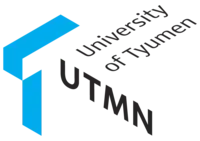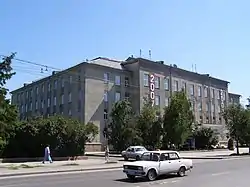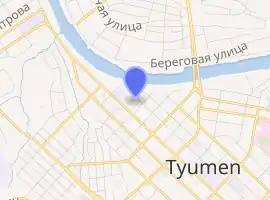University of Tyumen
Tyumen State University is a university in Tyumen, Russia. The University of Tyumen was the first university in Tyumen Oblast and was founded in 1930. Nowadays the UTMN consists of 15 institutes. The total number of students at the university is more than 27,000, including more than 1,900 international students. The total number of faculty and staff is more than 2,000.[1] Today the UTMN trains qualified specialists in 175 fields. The UTMN offers various forms of study: full-time, part-time, distance education, master's degree, undergraduate education, graduate, doctorate, advanced training, and second degree. The University is one of the participants of the Project 5-100 – the program of improving international competitiveness of the Russian institutions of higher education among the world's leading research and education centers.[2] Since 2013 Valeriy Falkov has been the rector of the UTMN. In January, 2020 Falkov was appointed as the Minister of Science and Higher Education of Russia.
Тюменский государственный университет (ТюмГУ) | |
 | |
Former names | Tyumen Pedagogical Institute |
|---|---|
| Established | 1930 |
| Rector | Ivan Romanchuk (acting) |
Academic staff | 1,200[1] |
| Students | 27,000[1] |
| Postgraduates | 342 |
| Location | 6 Volodarskovo Street, Tyumen , , 56°28′10″N 84°56′51″E |
| Campus | Urban |
| Website | https://www.utmn.ru/en/ |
Building details | |
 | |

| |
History
The development of universal primary education created a desperate need for professional teaching staff, for which reason in 1930 the first Tyumen higher educational institution was founded. Students of the Agricultural and Pedagogical Institute of Tyumen could study agriculture, chemistry, biology and physics.
The second half of 1930s saw the start of academic research. In 1935, an experimental plot was created. Scientific expeditions to the north of the Altai, studies of indigenous northern language and folklore and regional teaching courses for locals took place from 1936-1940.[3]
Everything changed with the start of World War II in July 1941. During its first year, more than a hundred of students, professors and other staff members went to the front. Nevertheless, the Institute continued working. In February 1942, it hosted an academic conference where 20 papers in the fields of mathematics, chemistry, geography, psychology, literature, Russian language and anti-fascism were presented. Among the participants were scientists from Boris Zbarsky's laboratory, who came to Tyumen as an escort to the mummy of Lenin that was being evacuated from Moscow. The head of the department of natural sciences, Ilya Zbarsky, was a senior research fellow of the laboratory.
In the 1960s, the fast development of West Siberian oil and gas industry influenced the Institute, which focused on finding the most effective ways of oil and gas extraction. On January 1, 1973, by the decision of the USSR Council of Ministers, the Pedagogical Institute became a State University. The first rector of the University was a doctor of Physics and Mathematics, Igor Aleksandrov.[4]
The University Structure
The University of Tyumen has 15 academic institutes:[5]
- Institute of Finance and Economics
- Institute of State and Law
- Institute of Mathematics and Computer Sciences
- Institute of Chemistry
- Institute of Physics and Technology
- Institute of Earth Sciences
- Institute of Biology
- Institute of Philology and Journalism
- Institute of History and Political Sciences
- Institute of Psychology and Pedagogy
- Institute of Physical Education
- Institute of Distance Education
- Institute of Environmental and Agricultural Biology (X-BIO)
- Regional Institute of International Cooperation
- School of Advanced Studies (SAS)
Overview
The UTMN campus is a unique urban infrastructure. Its territory includes educational classrooms, research centers, and multiple laboratories. The main territory of the UT campus is conveniently located in the historical part of the city of Tyumen. The student residences are located here as well. The Acting Rector of the UTMN (since April, 2020) is Ivan Romanchuk, PhD in Law, Associate Professor.
The University has more than 100 student associations dedicated to research, information, multicultural, creative, social, and sport activities. The University's developed infrastructure allows for field trips to Lukashino (Tyumen Oblast), Maksimikha (Republic of Buryatia), Solnyshko (Krasnodar region), Lake Kurchak (Tyumen Oblast), Priobsky proving ground (Khanty-Mansi Autonomous Okrug).
Within the Tempus Project and in order to promote a barrier-free learning environment at the University, the International Center of Inclusive Education has been established. Equipment for persons with special needs was purchased with grant funds. The engineer of the International Competence Center of Inclusive Education developed the electronic textbook for blind people – SEEALL.[6] The device enables obtaining writing skills and reading Braille, as well as sending text and audio messages from one module to another.
The development of international activity of the UTMN is based on cooperation with international partners in research, education, and cultural spheres. Currently, the University has 84[7] cooperation agreements with international higher education institutions and organizations, seven of which are the world's leading universities featured in the Top 200 according to the international THE, QS and ARWU rankings. The result of the cooperation is joint events at an international level and implementation of research and educational projects.
The University holds 4 international summer schools:
- STEP in Russian Energy: Society, Technology, Environment, Policy – educational program for international students. The School contributes to the students’ competence in the field of economy and geography of the Northern territories and basic knowledge of energy and natural resources regulations. One of the School's emphases is on studying Russian language, culture and history.
- Western Siberia: Life, History and Culture. The School's main purpose is teaching participants an anthropological approach to the study of Siberia and the North, as well as modern concepts of anthropology.
- Energy Policy in Eurasia is organized by the University of Tyumen in partnership with the European University at St. Petersburg. The program's participants get acquainted with the specific legal framework and with current trends of development of the Eurasian oil and gas sector.
- Explore your own Siberia. The School assists international participants in immersing themselves into the language environment, and to get acquainted with the cultural diversity of Russia, its Siberian traditions in particular.[8]
Research
Priority research areas of the UTMN:
- [Arctic: resources and environment]
- [Biological Security]
- [Digital Transformation of Petroleum Industry]
Global and Dual Education
The University of Tyumen is one of the employers of the Russian government's Global Education Program, aimed at preparing exclusive Russian experts at an international level in the priority directions of development of the Russian economy. It allows Russian undergraduate, graduate and doctorate students choosing one of 288 leading universities in 32 countries and receive grants for studying in MA and PhD programs and residency (medicine) in the fields of engineering, education, social administration, medicine and science.
The priority form of the University's development is collaboration with major enterprises. Its focus is the regional economy, associated with an increase in the number of new industries and the need to provide the major investment projects and production sites of the West Siberian region with modern engineering and managerial staff. The Polytechnic School has been established in order to modernize the training of engineering and technical staff at the University. Each educational program is designed together with representatives of a particular enterprise.
Conceptual Engineering of the Oil and Gas Deposits Master’s Program
Currently, the UTMN Polytechnic School is the country's only educational platform preparing experts in conceptual engineering for the oil and gas sector. Partner of the Program is Gazprom Neft Company.[9] The main distinction and advantage of the Program is direct contacts with Russian and international technology companies and with leading research, design and engineering centers in Russia. The students participate in the implementation of engineering projects for the deposits of Gazprom Neft.
Basic Department of Measurement of Oil and Gas Flow
The basic department is used for educational and research purposes. A unique scientific test bench was created within a joint project of the UT and the HMS Neftemash Enterprise, within the framework of Government Regulations. In the course of the training, UTMN students participate in active industrial projects for designing and implementing machinery and equipment for the development of oil and gas sites. Knowledge of modern industrial technologies and experience of applied research extends the scope of competence of the graduates.
Famous alumni
- Dmitriy Artyukhov - Russian politician, the governor of the Yamal-Nenets Autonomous District.
- Vladimir Bogomyakov – Russian poet.
- Sergey Vasilyev – Russian politician and journalist.
- Olga Izhenyakova – writer, journalist.
- Nina Kondratkovskaya – Russian poet, journalist and educator.
- Galina Kukleva – Russian biathlete, Olympic champion and three times world champion.
- Konstantin Lagunov – historian and writer.
- Miroslav Nemirov – Russian poet, writer, rock-group member, columnist of the Russian Journal.
- Alexander Moor - Russian politician, the governor of Tyumen Province.
- Konstantin Odegov – Russian actor, film director, producer and journalist.
- Nikolai Pavlov – Russian politician.
- Dmitry Pashkin – Russian literature specialist and musician.
- Alexander Petrushin – Tyumen historian and ethnographer.
- Sergey Savin – Russian volleyball player, member of Russia men's national volleyball team and Russian club Lokomotiv Novosibirsk.
- Valeriy Falkov - Russian politician, the Minister of Science and Higher Education of Russia
- Yefim Feldman – soviet Moldavian geographer.
- Vladimir Cheboksarov – soviet former wrestler.
- Vladimir Yakushev – Russian politician, the Minister of Construction and Ifrastructure of Russia.
References
- "About Tyumen State University". Tyumen State University. Retrieved 5 October 2016.
- "University of Tyumen in 5-100 Project". 5-100 Russian Academic Excellence Project. Retrieved 11 October 2016.
- Encyclopedia of Tymen State University. Tyumen, Tyumen State University Press. 2015. 584 p. ISBN 978-5-400-01108-5
- A. Krinitsky, A. Pridorozhny. From Institute to University. Tyumen State University in 60s-70s. // UTMN Vestnik. 1999. No.2. p. 213-215.
- "About Tyumen State University". Tyumen State University. Retrieved 5 October 2016.
- "Russia: SEEALL with Russia's brand new braille e-reader". Youtube.com. Retrieved 18 October 2016.
- "Tyumen State University International Partners". Tyumen State University. Retrieved 18 October 2016.
- "Website of the UT Summer Schools". Tyumen State University. Retrieved 18 October 2016.
- "Conceptual Engineering of the Oil and Gas Deposits Master's Program". Tyumen State University. Retrieved 18 October 2016.